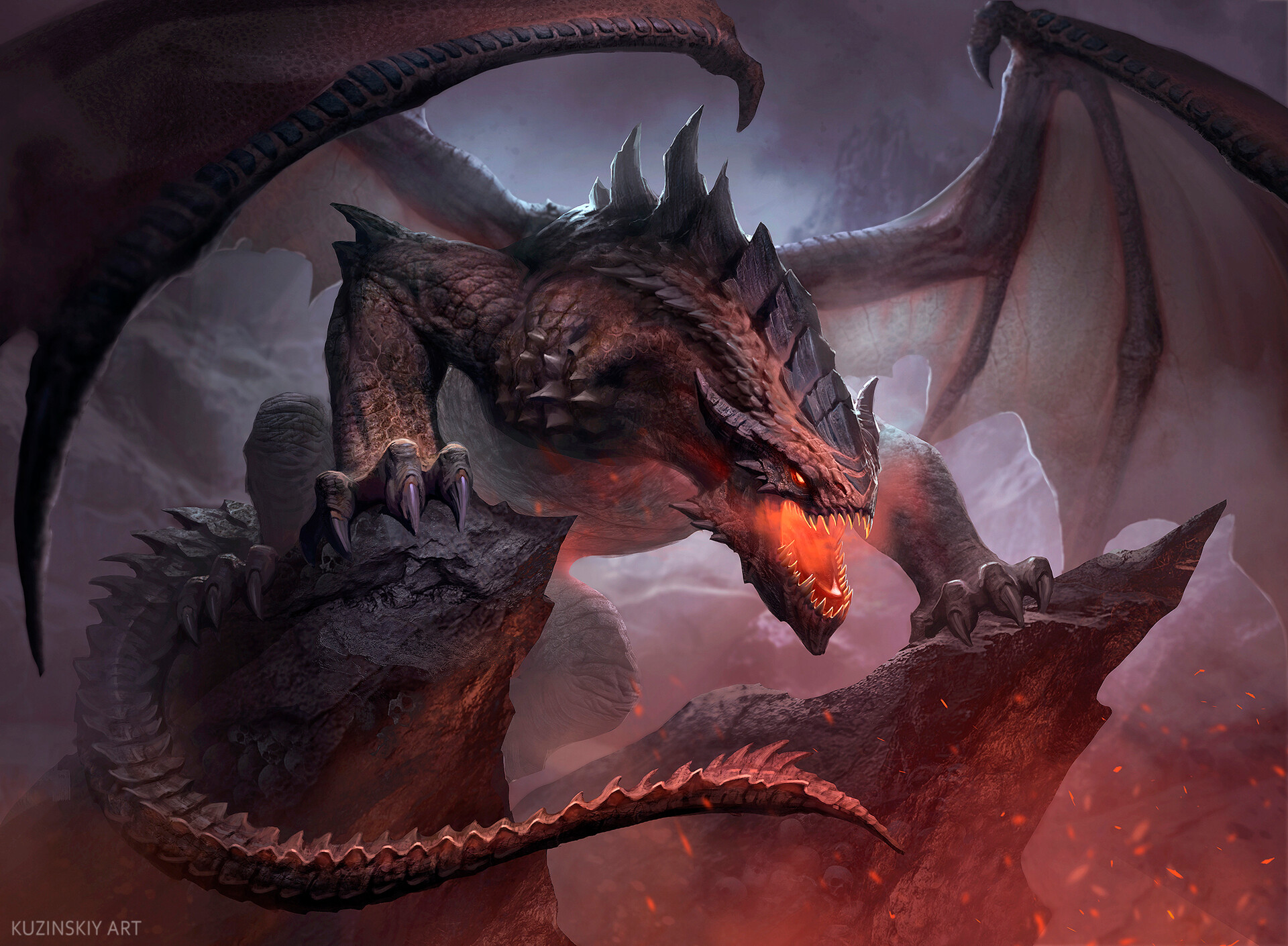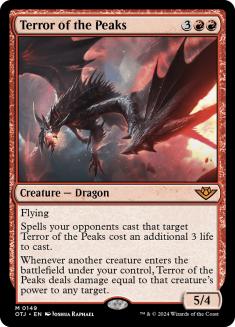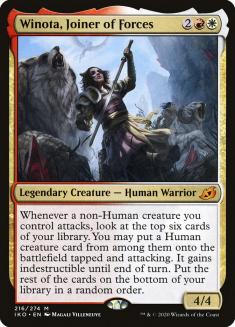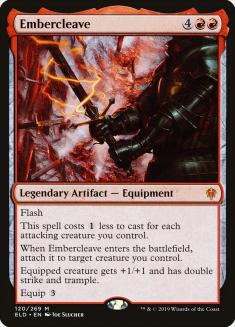I’m not going to act like you’re not up to speed.
Core Set 2021 Standard is vastly different now due to the bans last Monday and I’ve been hammering away. A massive shakeup is basically a dream come true for me, as many oppressive strategies disappearing is actually a large net-gain in Standard diversity due to so many potential cards and synergies becoming “unlocked,” generating a massive amount of content to explore and uncover.
So massive, in fact, that I’ll only be covering a subset of things to explore today, notably due to the fact that it gave me a reasonable hook and framing device, some powerful red mythics.
I’ve been posting a lot of different stuff on Twitter too, which I’ll likely cover more over the following weeks, and I’ll likely keep up similar pace for a while (learned that trick from Gerry) as long as it’s clear that Core Set 2021 Standard is engaging for me, but regardless we’ll have plenty of stuff to do before Zendikar Rising, a breath of fresh air after the last few months.
I identified these three cards as specific big winners from the bans. Not that they haven’t had their time to shine in Standard — Embercleave is a staple in Red-based Aggro; Winota, Joiner of Forces has gotten a lot of press and most recently Michael Jacob pioneered Mardu Winota; and Terror of the Peaks has seen fringe play, but they’re all massively powerful cards that not only benefit from the surrounding metagame growing weaker, but simply are nongreen cards that were impactful enough to see play while everyone was knocking on five mana on Turn 3.
More specifically, Terror of the Peaks and Embercleave in particular are beneficiaries from the ban of Teferi, Time Raveler, the former alongside all creatures without an enters-the-battlefield trigger and the latter since its cost reduction and flash were shut off under Teferi.
Let’s start with Terror of the Peaks.
Terror of the Peaks
Bryan Gottlieb has made it a point of poking fun at my praise of Terror of the Peaks immediately after the bannings — citing something to the effect of “Majors is delusional if he thinks that just because of these bannings we can all play engine-less Magic.” Frankly, that’s true. It’s been true longer than since 2018, as any successful deck operating without an engine was either extremely aggressive, had disruption, or a combination of both.
I posted a couple of decklists to share some thoughts and to get the hivemind’s brain online again, but I have no illusions that good fundamental deckbuilding is out the window just because information has been stripped from the internet and competitive pressure at the tail end of this Standard life cycle is low.
So why is Terror of the Peaks strong now?
Because it’s a powerful enough card that it’s worth taking risks on your investments now. Previously, it wasn’t. I couldn’t possibly invest five mana into a play with no immediate return when my opponent could spend two less mana and be up a card and a planeswalker.
Now I can incur the risk because the reward potential is so high. Furthermore, there are plenty of decks that are interested in Terror of the Peaks that can generate so much mana that it can be the first play in a turn, generating a pseudo-enters-the-battlefield effect and often winning the game on the spot.
The last place where Terror of the Peaks benefits is now that there is only one primarily played way to remove it without triggering its “fire armor” — Elspeth Conquers Death — it can be leveraged as potential top-end in an aggressive shell.
All right, I’ve set this up enough.
Decklists
Let’s get the boring one out of the way:
Creatures (26)
- 4 Lovestruck Beast
- 4 Beanstalk Giant
- 4 Edgewall Innkeeper
- 4 Bonecrusher Giant
- 4 Fae of Wishes
- 4 Brazen Borrower
- 2 Terror of the Peaks
Lands (27)
Spells (7)

Terror of the Peaks is at its best when a deck has a bunch of mana lying around and it can produce pressure. Temur Adventures checks those boxes: you’ll never run out of cards to trigger the Terror, and Beanstalk Giant quickly ends the game on the spot when triggered, just like the backdoor Fling kill from Fae of Wishes.
I’m not completely crazy, so I added a Cultivate since I net added another five-mana card to the deck. And while I’m not exactly sure that this deck needs the additional power, sometimes it does feel like it flounders some when it can’t assemble Lucky Clover plus Granted.
Aether Gust isn’t exactly that strong in the mirror either, so if Temur Adventures does emerge as the de facto deck to beat, this could be a reasonable innovation to the strategy.
Creatures (28)
- 3 Paradise Druid
- 4 Risen Reef
- 4 Omnath, Locus of the Roil
- 4 Leafkin Druid
- 4 Cavalier of Thorns
- 4 Uro, Titan of Nature's Wrath
- 2 Yorion, Sky Nomad
- 3 Terror of the Peaks
Lands (28)
Spells (4)
Sideboard

This is a solid representation of the stock Temur Elementals deck, which I think has been massively under-discussed considering how much stronger it has gotten given the bans. This is an excellent Terror of the Peaks deck for myriad reasons: huge amounts of mana in the late-game; playing side by side with Uro, Titan of Nature’s Wrath; and a lot of combo kill potential with both Genesis Ultimatum and Yorion, Sky Nomad.
Don’t sleep on this deck even if Temur Adventures is getting most of the love.
Creatures (34)
- 4 Paradise Druid
- 4 Arboreal Grazer
- 2 Questing Beast
- 4 Bonecrusher Giant
- 2 Stonecoil Serpent
- 2 Brazen Borrower
- 3 Illuna, Apex of Wishes
- 4 Pollywog Symbiote
- 4 Gemrazer
- 3 Sea-Dasher Octopus
- 2 Terror of the Peaks
Lands (26)

You’re probably noticing a common theme of Terror going well in Temur decks. Acceptable mana + acceleration is really the ticket.
I don’t think that Temur Mutate really got its fair shake — granted, what was going on previously was extremely powerful. I haven’t played a ton with this deck, but I like the feel of it so far. You have a good mix of pressure and ability to go over the top of opponents, and you even incidentally play a good number of strong blockers in the early-game against aggression.
Notably the stock of Gemrazer has gone down quite a bit, but tagging an Anax, Hardened in the Forge is still backbreaking.
Winota, Joiner of Forces and Embercleave
There’s a fair amount of overlap between these two powerful mythics. Not only do I think that Embercleave has been underexplored in general, Winota is already so interested in generating wide battlefields that it feels criminal to not explore them together.
Starting a little tame:
Creatures (28)
- 4 Venerated Loxodon
- 4 Venerable Knight
- 4 Worthy Knight
- 4 Fervent Champion
- 2 Rimrock Knight
- 2 Winota, Joiner of Forces
- 4 Basri's Lieutenant
- 4 Selfless Savior
Lands (24)
Spells (8)

To frame this exploration a little bit and reiterate: both Winota and Embercleave need wide battlefields for set-up. Further, Raise the Alarm naturally lends itself to wide battlefields while also fueling Venerated Loxodon, so that’s roughly how you get here. I also went into all of this wanting to try to abuse Tournament Grounds since I want to play Embercleave and Basri’s Lieutenant anyway, so then it just becomes a matter of filling in the holes.
To be frank, this isn’t the “best” Winota deck. You don’t have endless ways to trigger it – it’s fairly difficult outside of drawing Raise the Alarm – but Basri’s Lieutenant gives so much potency to even meager hits that I think it’s worth playing. The mana in this deck is extremely good for a two-color aggro deck, and you get to play on-curve frequently while tapping into a bunch of powerful engines.
Notably, I think leaning into a Legion Warboss / Winota / interaction sideboard plan is also underexplored.
Next, slightly more ambitious:
Creatures (32)
- 3 Judith, the Scourge Diva
- 4 Lazotep Reaver
- 4 Knight of the Ebon Legion
- 4 Fervent Champion
- 2 Blacklance Paragon
- 4 Stormfist Crusader
- 3 Woe Strider
- 4 Winota, Joiner of Forces
- 4 Basri's Lieutenant
Lands (25)
Spells (3)

Same concept, except trading off consistency for power.
This is the kind of deck that really excites me. The cards are almost unanimously hard-hitting (look, even Lazotep Reaver generates a +1/+1 counter for backdoor Basri synergies!), which is something I like more than the set up of traditional Mardu Winota that both has a bunch of role-players and is reliant on A+B synergies.
You can roll over people just by curving out and presenting either Winota or Embercleave on Turn 4, or play a deeper game with Knight of the Ebon Legion; Woe Strider; Basri’s Lieutenant; and Judith, the Scourge Diva.
Is it consistent enough? Do I want (or need fewer?) small-ball components to fuel the engines? These are hard questions to answer, as there are so many different permutations of cards available for a deck like this. Oddly, Fervent Champion has been the most disappointing card so far, but it also feels criminal to not play the eight “good” one-drops in a deck with Embercleave.
I sort of wanted to put this next deck last since it’s the goofiest, but let’s just say we’re closing out the Winota section instead:
Creatures (24)
- 2 Irencrag Pyromancer
- 4 Drannith Stinger
- 4 Flourishing Fox
- 4 Valiant Rescuer
- 4 Drannith Healer
- 2 Winota, Joiner of Forces
- 4 Jolrael, Mwonvuli Recluse
Lands (18)
Spells (18)

So, let’s get this part out of the way: regardless of the ultimate details, Jolrael is extremely strong in cycling, and Flower // Flourish is perfect for bridging her castability and also being another potential knock-out punch since the deck is capable of going so wide now.
This archetype in general, as linear and silly as it seems to some, deserves more respect moving forward as something still worthy of time and innovation.
Now, the Winota element — sure, it’s pretty easy to write it off as nonsense with only eight cards capable of triggering it, but hitting here is still strong. You generate cardboard on the battlefield that has the benefit of powering up Zenith Flare when they die, but they also all have triggered abilities. Irencrag Pyromancer is another really powerful and underplayed card in the archetype, and for now this duo is enough for me to relegate Lurrus to the sideboard for when I want to grind against removal-heavy decks.
Ultimately, I think that’s fine. These decks’ sideboards basically suck anyway, since you never want to remove too many of your cycling pieces. It is a nice benefit that Wilt actually does legitimate double duty.
This is probably my second-favorite deck in this article.
The Other Embercleave Decks
I feel like there’s been some accepted truth, even outside of perhaps the presence of Teferi, Time Raveler, that Embercleave only belongs in Mono-Red and Questing Beast decks. It’s really really hard to close games out with a single flyer while trying to answer or contain all of your opponent’s hyper-powerful threats, so why aren’t Izzet players just trying to kill people?
Creatures (17)
Lands (22)
Spells (21)
Sideboard

An underrated aspect of Embercleave is that it’s still extremely strong (and probably most frequently cast!) for four mana.
Now, again, this is another situation where I won’t act like this deck is particularly well-built. This is my third version and I’ve gotten progressively less flash-oriented to trying to be ever so slightly more tap-out (likely again to the distaste of Bryan G. – I swear I’m not picking on you!), but if you’re going to be singularly threat-minded, then you want hard-hitting ones like Stormwing Entity and Sprite Dragon that conveniently synergize with Embercleave’s casting.
I’ve run into a Temur list that even played Quirion Dryad, which is another good wielder of Embercleave. Explore just killing people with your Izzet decks!
Finally…
Creatures (16)
- 2 Spectral Sailor
- 4 Nightpack Ambusher
- 4 Bonecrusher Giant
- 4 Brazen Borrower
- 2 Uro, Titan of Nature's Wrath
Planeswalkers (3)
Lands (28)
Spells (14)
Sideboard

If you’re thinking to yourself that I’m just trying to prove a point at this stage…that’s true in some ways. The amusing part of these Triome decks just “splashing” a spell or two is that they also incidentally can end up with sixteen “freerolled” sources of their splash color. We’re definitely taking advantage of that.
Like I’ve said, trying to control the game for an extremely long period of time is just so difficult, and even adding Hydroid Krasis to try to snowball the game with Nissa isn’t always going to be foolproof if your opponent is simply more dedicated to playing a long contest. Just kill them.
To be clear, this is very experimental, but I suspect that a lot of our heuristics of what was correct to do — even with extremely powerful mythic rares — are outdated.
Most important, enjoy this new Standard format. I know I sure am.





